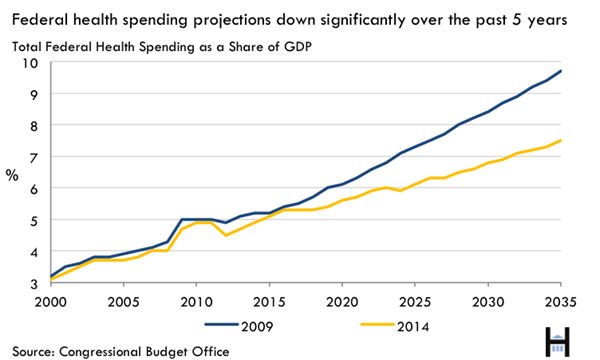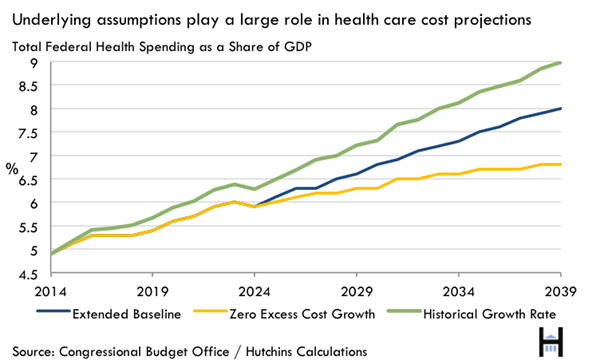One of the biggest drivers of projections for future Federal Government budget deficits is healthcare spending. Baby boomers have already started to retire. The group is expected to add considerably to the number of people on the Medicare and Medicaid rolls over the next 10-20 years.
While healthcare spending is expected to increase, recent trends indicate the pace of growth may be much slower than previously anticipated. Over the last five years, healthcare spending has grown at a historically low rate. According to the Congressional Budget Office’s new projections, this trend could continue. In its annual 25-year federal budget forecast, the CBO projected that growth in federal spending on healthcare programs will continue to decelerate over the next 25 years. In fact, in its most recent forecast, the CBO projected that government healthcare spending would be about $250 billion less than it forecast in 2010, the year the Affordable Care Act was signed into law.
The CBO’s new projections indicate that federal spending on major healthcare programs – Medicare, Medicaid, the Children’s Health Insurance Program and federal subsidies for people buying insurance on the new Obamacare-established exchanges – will increase from about 4.9% of GDP in 2014 to roughly 7.5% in 2035. This increase is meaningfully lower than the 9.7% the CBO projected five years ago.
Brookings Institute
The CBO attributed the continued deceleration in healthcare costs to several factors, including slower overall projected economic growth and lower-than-projected interest rates. The CBO also suggested for the first time that the federal government could possibly keep the pace of cost increases in line with overall inflation, based on the requirements contained in the Affordable Care Act.
Of course, these are only projections, and we know that actual results can differ quite markedly from expectations. As shown below, how large a share of GDP health care spending is relative to GDP can vary quite dramatically depending on the associated growth rate in costs.
BWFA Investment Approach
While we do not know how fast health care costs will rise, we do expect them to move higher. When selecting stocks for inclusion in client portfolios we favor companies that can help lower overall healthcare costs. There are three types of companies we favor: (1) those that can improve the efficiency of operations for healthcare related firms and businesses; (2) those that can lower overall treatment costs through better, more efficacious treatments; or (3) developing new drugs for unmet medical needs.




